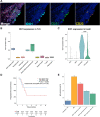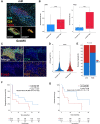Upregulation of Indoleamine 2,3-Dioxygenase 1 in Tumor Cells and Tertiary Lymphoid Structures is a Hallmark of Inflamed Non-Small Cell Lung Cancer
- PMID: 37756581
- PMCID: PMC10690088
- DOI: 10.1158/1078-0432.CCR-23-1928
Upregulation of Indoleamine 2,3-Dioxygenase 1 in Tumor Cells and Tertiary Lymphoid Structures is a Hallmark of Inflamed Non-Small Cell Lung Cancer
Abstract
Purpose: Overexpression of the tryptophan-catabolizing enzyme indoleamine 2,3-dioxygenase 1 (IDO1) has been reported in several tumor types, including non-small cell lung cancer (NSCLC), and has been shown to promote tumor-immune evasion and inhibit T-cell activation through increased tryptophan degradation and the production of several immunosuppressive metabolites collectively known as kynurenines. However, it remains unclear whether IDO1 expression by tumor cells is detrimental specifically in the context of programmed cell death protein 1 (PD-1)/programmed death ligand 1 (PD-L1) axis blockade.
Experimental design: We analyzed the transcriptome of 891 NSCLC tumor samples from patients enrolled in two large randomized clinical trials investigating the safety and activity of atezolizumab, a humanized IgG1 mAb that targets PD-L1, versus docetaxel in patients with advanced NSCLC. We complemented these transcriptomics results at the protein level by using multiplex immunofluorescence and at the functional level with in vitro experiments.
Results: The increased expression of the tryptophan-catabolizing enzyme IDO1 was significantly associated with improved objective response, progression-free survival, and overall survival in patients treated with PD-L1 inhibitors, but not in those treated with chemotherapy. Strikingly, inflamed tumors had higher levels of IDO1, and IDO1 was also expressed in tertiary lymphoid structures (TLS) by mature follicular dendritic cells. L-kynurenine impaired the differentiation of antibody-producing B cells induced by follicular helper T (Tfh)/B-cell interactions, a hallmark process within TLS.
Conclusions: IDO1 pathway in NSCLC is driven by the immune system rather than by tumor cells. Targeting IDO1 in combination with anti-PD-1/PD-L1 might be beneficial only in patients with inflamed tumors and particularly in those bearing TLS.
©2023 The Authors; Published by the American Association for Cancer Research.
Figures





References
-
- Herbst RS, Giaccone G, de Marinis F, Reinmuth N, Vergnenegre A, Barrios CH, et al. . Atezolizumab for first-line treatment of PD-L1-selected patients with NSCLC. N Engl J Med 2020;383:1328–39. - PubMed
-
- Camidge DR, Doebele RC, Kerr KM. Comparing and contrasting predictive biomarkers for immunotherapy and targeted therapy of NSCLC. Nat Rev Clin Oncol 2019;16:341–55. - PubMed
-
- Mellor AL, Munn DH. IDO expression by dendritic cells: tolerance and tryptophan catabolism. Nat Rev Immunol 2004;4:762–74. - PubMed
Publication types
MeSH terms
Substances
Grants and funding
LinkOut - more resources
Full Text Sources
Medical
Research Materials

